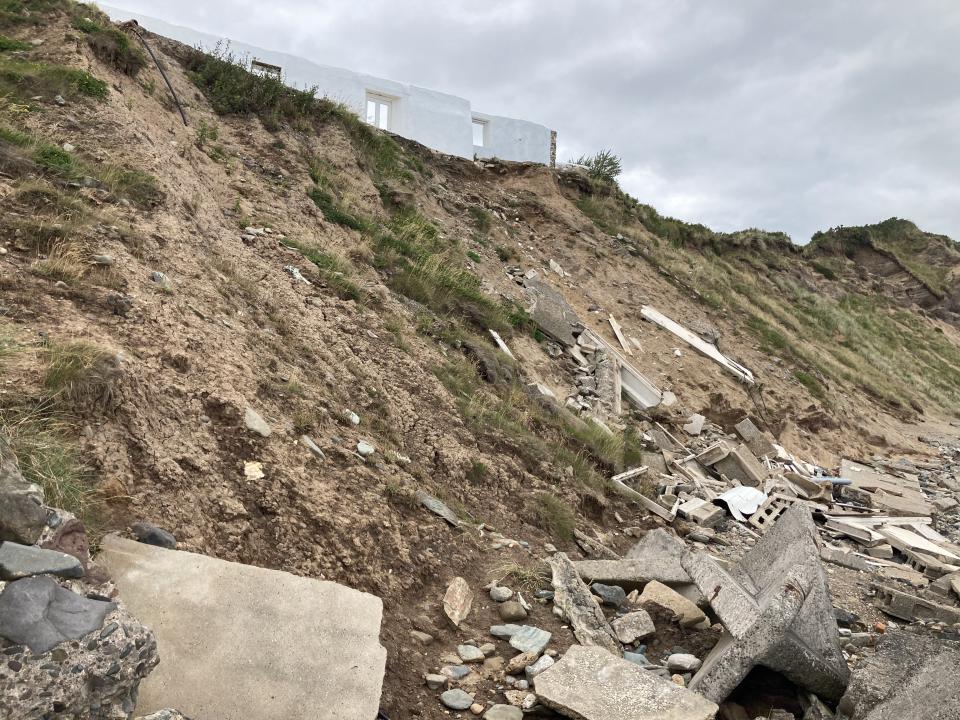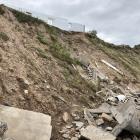Facing Britain across a rough sea, County Wexford has long been prone to incursions—both political and environmental. Its shores have seen the arrival of Celts and Cambro-Normans, saints, settlers, and soldiers. Comprised of soft glacial cliffs and sandy beaches, the southeastern coastline of Ireland is dominated by unconsolidated Quaternary-aged sediments with fewer rock exposures than Ireland’s other coasts. It is vulnerable to coastal erosion—the loss or displacement of land due to the action of waves, tides, near-shore currents, and storms. Although erosion has always occurred, increased human migration to the coast, human interference with the coastal zone (coastal defences, land reclamation, vegetation clearing, dredging), and a climate-related rise in sea level has worsened its impact.
The permeability of Wexford’s coastline is so pervasive as to be nearly invisible, part of a long-neglected political ecology now being addressed by historians. A complex treatment of the entanglements of human, political, and environmental histories along the Wexford coastline can however be found in the work of Colm Tóibín. His novels model the role of literature as what Anna Pilz describes as “a historical archive that shaped (and continues to shape) the dissemination and reception of narratives of Ireland’s environmental history.”
Tóibín grew up in Wexford, surrounded by stories of colonial oppression and brave nationalist resistance. He first revised that history via the character of a high-court judge in The Heather Blazing (1992). But even as he set about dismantling myths and imagining a new, more inclusive Ireland, Tóibín kept the soft coastline of his native county in view. In The Heather Blazing, “gradual” and “slow” erosion became suddenly evident when a house “fell down onto the strand.” A missing wall opens onto “the bare, raw light from the sea.”
Coastal communities are already feeling the impact of climate change. Some residents living in southeast Ireland fear they may have to abandon their homes because of the threat of coastal erosion.
Tóibín’s engagement with the materiality of coastal erosion is most evident in The Blackwater Lightship (1999), an elegiac account of an estranged family brought together to nurse Declan who is dying from AIDS. Declan’s illness finds another register in the fragility of the southeast coastline upon which the Devereux home rests, where “fine grains of sand pouring down each layer of cliff” enact “a slow measured loosening of the earth.” The section of sandy coastline at Blackwater Head eroded up to 2.8 meters annually in the period 1973–2011, with a projected loss of 72 hectares of agricultural land. The novel inscribes the cliff as an unstable space of memory. It crumbles away to reveal the living history of coastal erosion.
The locations of The Blackwater Lightship—Ballyconnigar and Blackwater—are places impacted by coastal erosion. The jagged temporalities of the sea’s action on the land are scarcely understood in the novel: “From here as far as Keatings’ the erosion had stopped or slowed down,” Declan’s sister Helen recalls. “No one knew why. Years earlier, it had seemed just a matter of time before her grandmother’s house would fall into the sea, just as Mike Redmond’s and Keatings’ outhouse had done.”
There used to be a big beach, and now it has all gone, replaced by rocks trying to stop the erosion. Ballyconnigar beach, Blackwater, County Wexford.
The novel imagines erosion in relation to other coasts. The eastern seaboard differs from the romantic Atlantic landscapes of the West: “the marl of the cliff and the short strand” in The Blackwater Lightship seem “dirty” and “strange” compared to the “long sandy beaches in Donegal.” Other Irish Sea writers have noted these colliding coastal imaginaries. In Conor O’Callaghan’s poem, “East,” “all that elemental Atlantic guff” is punctured by “a trickle of shingly beaches that are less than clean.” In Tóibín’s novel of transatlantic migration, Brooklyn (2009), a discussion of New York’s beaches takes place once Eilis and friends have descended to the sea via Cush Gap. This access point—that Eilis knows from a childhood spent observing changes to the coastline over summer visits—had already been taken away by the sea at the time of Tóibín’s writing.
Despite the significance of the Wexford coastline for Declan in The Blackwater Lightship, his early experience of the Irish Sea is registered in negative mode. He and his sister Helen are taught to look away from the sea by their grandparents, who “behaved as though it were not there . . . They paid no attention to the sea, and Helen and Declan learned to pay no attention to it either.” Against this culture of sea blindness, Tóibín’s fiction insists that readers look at Ireland’s eroding southeastern coast, a landscape in the process of “falling, dissolving, being washed away, not being there anymore.”
“We Have Always Been Your Harbour” is a 25-minute play for voices, written and produced by Wexford writer and performer Peter Murphy, recorded, scored and coproduced by Rosslare native Dan Comerford. The piece was initially conceived as a response and homage to Dylan Thomas’s 1954 radio play Under Milk Wood, relocated to present-day Rosslare Harbour. It takes the form of a series of monologues by unnamed voices, drawing on the history, folklore, and landscape of the area as well as interviews with Rosslare residents, including a ferry crew, port workers, local historians, writers, and photographers.
That dissolution echoes Declan’s physical decline. His death throes synchronise with the flashes of the Tuskar Lighthouse across the bay. In the face of roaring waves, the narrative concludes with the realization that “there was no need for people, that it did not matter whether there were people or not. The world would go on.” In the shadow of Declan’s death, the “resolute hardness” of the sea meets a soft coast, expressive of long geomorphological timelines in which the individual is subsumed by the ocean, just like “the mark and the mud and the dry clay of the cliff that were eaten away by the weather, washed away by the sea.”
Tóibín’s intimate knowledge of the vulnerable southeastern coastline shapes his imagination and enhances our understanding of the Irish Sea at a time of hastening crisis. Literature mingles with the historical record and the deep time of erosion to express tangible and intangible forms of loss. Like the fragile North Sea lowlands or the English east coast and fens, Ireland’s southeastern coast is receding by the day. Tóibín’s work contributes to a growing patrimony of stories that draw our attention to this environmental loss.
PRIMARY SOURCES
- O’Callaghan, Conor. “East.” In Seatown. Oldcastle: The Gallery Press, 1999.
- Tóibín, Colm. The Heather Blazing. London: Pan Books, 1992.
- Tóibín, Colm. The Blackwater Lightship. London: Picador, 1999.
- Tóibín, Colm. Brooklyn. London: Picador, 2009.
- Tóibín, Colm. “A Guest at the Feast.” In A Guest at the Feast. New York: Scribner, 2023.
How to cite
Connolly, Claire, Ailbhe McDaid, and James L. Smith. “‘Too Much Loose Sand’: Narrating Coastal Erosion in Southeast Ireland.” Environment & Society Portal, Arcadia (Autumn 2023), no. 23. Rachel Carson Center for Environment and Society. doi:10.5282/rcc/9753.
ISSN 2199-3408
Environment & Society Portal, Arcadia
 This work is licensed under a Creative Commons Attribution 4.0 International License.
This work is licensed under a Creative Commons Attribution 4.0 International License.
2023 Claire Connolly, Ailbhe McDaid, and James L. Smith
This refers only to the text and does not include any image rights.
Please click on an image to view its individual rights status.
- Allen, Nicholas. Ireland, Literature, and the Coast: Seatangled. Oxford: Oxford University Press, 2021. doi:10.1093/oso/9780198857877.001.0001.
- Murphy, Robinson. “‘Pain Comes in Waves’: Eroding Bodies in Colm Tóibín’s The Blackwater Lightship.” Critique: Studies in Contemporary Fiction 62, no. 5 (2021): 552–63. doi:10.1080/00111619.2020.1842317.
- Pilz, Anna. “Narratives of Arboreal Landscapes.” In A History of Irish Literature and the Environment, edited by Malcolm Sen, 97–114. Cambridge: Cambridge University Press, 2022. doi:10.1017/9781108780322.005.
- Ritson, Katie. The Shifting Sands of the North Sea Lowlands: Literary and Historical Imaginaries. Abingdon: Earthscan, 2019. doi:10.4324/9780429490644.
- Sen, Malcolm. “A History of Irish Literature and the Environment.” In A History of Irish Literature and the Environment, edited by Malcolm Sen, i–ii. Cambridge: Cambridge University Press, 2022.











